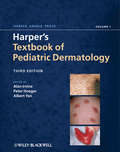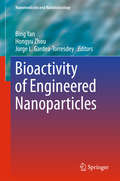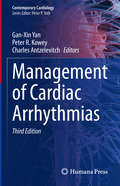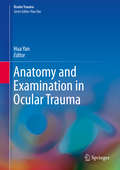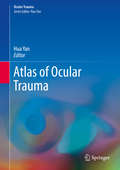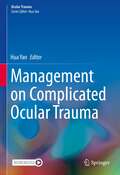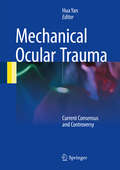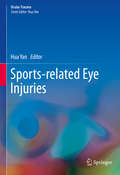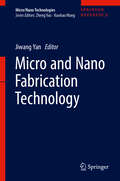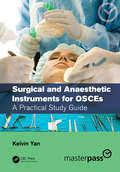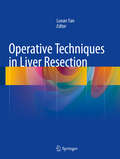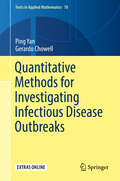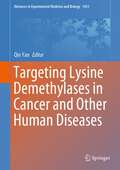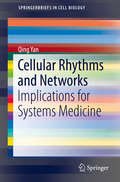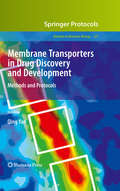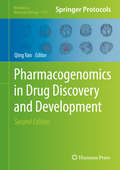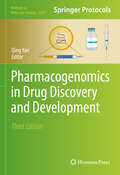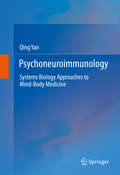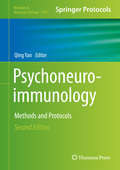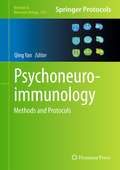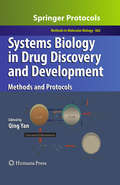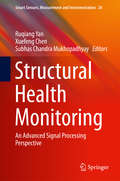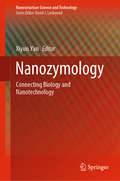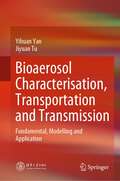- Table View
- List View
Harper's Textbook of Pediatric Dermatology
by Albert C. Yan Alan D. Irvine Peter H. HoegerThe third edition of this highly regarded text continues to provide a comprehensive resource for pediatric dermatologists. The book offers evidence-based diagnosis and treatment recommendations and covers both common and rare conditions, including emerging conditions and research, especially at the genetic level. A refreshing new text design makes the book more accessible, and new editors and contributors bring a distinctly international perspective to the work.
Bioactivity of Engineered Nanoparticles (Nanomedicine and Nanotoxicology)
by Bing Yan Hongyu Zhou Jorge L. Gardea-TorresdeyThis book brings together reviews from international experts who are exploring the biological activities of nanomaterials for medical applications or to better understand nanotoxicity. Topics include but are not limited to the following: 1) mechanistic understanding of nanostructure-bioactivity relationships; 2) the regulation of nanoparticles' bioactivity by means of chemical modification; 3) the new methodologies and standard methods used to assess nanoparticles' bioactivity; 4) the mechanisms involved in nanoparticle-biomolecule interactions and nanoparticle-cell interactions; and 5) biomedical applications of nanotechnology. The book will be a valuable resource for a broad readership in various subfields of chemical science, engineering, biology, environment, and medicine.
Management of Cardiac Arrhythmias (Contemporary Cardiology)
by Gan-Xin Yan Peter R. Kowey Charles AntzelevitchA significantly expanded third edition, this book provides a comprehensive and concise overview of cardiac arrhythmias and their ECG/telemetry manifestations, including the principles of cardiac electrophysiology, current concepts of pharmacology, clinical features, diagnoses, and state-of-the-art treatments. Additionally, the book emphasizes decision-making strategies in approaching each individual patient and the application of technical innovations in specific clinical situations. Organized into eight parts, beginning chapters introduce the concepts and principles of cardiac electrophysiology, unique rhythms, and ECG waves/signs. These chapters are designed to integrate emerging knowledge in basic science and clinical medicine. Subsequent chapters focus on the diagnosis of a variety of cardiac arrhythmias using non-invasive methodology. Throughout the book, chapters continue to analyze pharmacological and other approaches to therapy of specific arrhythmias, including supraventricular tachycardias, atrial fibrillation and flutter, ventricular arrhythmias, and bradyarrhythmias. Finally, the book closes with coverage on inherited cardiac arrhythmia syndromes including the long, short QT, and J-wave syndromes, catecholaminergic polymorphic ventricular tachycardia, and arrhythmogenic right ventricular cardiomyopathy. The third edition of Management of Cardiac Arrhythmias, is an essential resource for physicians, residents, fellows, and medical students in cardiology, cardiac surgery, vascular surgery, cardiac electrophysiology, and cardiac radiology.
Anatomy and Examination in Ocular Trauma (Ocular Trauma)
by Hua YanThis book aimed to provide the most thorough knowledge of ocular anatomy related to trauma and standard ocular examinations to clinical practitioners, such as the nurses, medical students, residents, fellows and even ophthalmologists, to help them making the most appropriate decision on the management of patients who have suffered from such ocular conditions. A thorough understanding of the anatomy of the eyeball and the traumatic characteristics of each structure of the eyeball are a prerequisite for proper interpretation of long-term outcomes of mechanical eye injuries.The first part provides the audiences general information of ocular anatomy, which will help them understand the basic anatomic knowledge and generate a clinical thinking. The following part provides the detailed examinations. They will help readers to make the right diagnose and offer the best advice or treatment to the patients. For each chapter, detailed clinical workup, clinical presentations and signs, and pictures or illustrative figures will be provided. Part 3 will benefit more medical coworkers to be familiar with the registration system of ocular trauma and its social and medical meaning. This will also help the advances of epidemiology and proper treatment approaches for ocular trauma. Hopefully this book may help the clinical practitioners to be fully prepared for any challenge of ocular traumatic cases.
Atlas of Ocular Trauma (Ocular Trauma)
by Hua YanThis book aims to provide comprehensive pictures of ocular trauma illustrating signs, examinations and surgical procedures to clinical practitioners including the nurses, medical students, residents, fellows and ophthalmologists, and help them make the appropriate decision on the diagnosis and management of such patients. <p><p> The first chapter gives a general introduction of ocular trauma which helps clinical practitioners generate the basic ideas of classification of ocular trauma and understand general principles of examination and first-aid management of such patients. The following chapters cover all types of ocular trauma with the comprehensive pictures combined with brief case studies. For each disease, a brief introduction, explanation as well as management are offered to the readers. With the illustrative figures, making the right diagnose, offering the best advice or treatment to the patients, and understanding surgical procedures would be easily achieved. The highlight of this book is that the diagnosis and treatment of each disease are concentrated on the pictures and practitioners would understand a sign or even a disease in one visual sweep. Since ophthalmology is such an imaging-heavy specialty, and ocular trauma comes as an emergency condition at most of the time, making the right decision for ocular traumatic patients the first glance is necessary for daily clinical practice. Hopefully this book may help the audiences to be prepared for any challenge of ocular traumatic cases.
Management on Complicated Ocular Trauma (Ocular Trauma)
by Hua YanThis book is aimed at illustrating the common complicated ocular trauma with typical signs, examinations, surgical procedures and conservative management to clinical practitioners including the nurses, medical students, residents, fellows and ophthalmologists, and help them make the most appropriate decision on the diagnosis and management of such patients. There are 23 chapters introduced in the book, which covers all types of complicated ocular trauma with brief case reports combined with the most comprehensive pictures. For each disease, a brief introduction, explanation as well as management are offered to the readers. With the illustrative figures and explanations, the goal of making the right diagnose, offering the best advice or treatment to the patients, and understanding surgical procedures would be easily achieved. This book is useful for readers to be fully prepared for the challenge of complicated ocular traumatic cases.This is the fifth volume of the book series Ocular Trauma.
Mechanical Ocular Trauma
by Hua YanThis book provides state-of-the-art information for ophthalmologists and other clinicians facing tough cases, helping them to make the most appropriate decision concerning the management of patients who have suffered mechanical ocular trauma. The discussion of mechanical ocular trauma addresses various parts of the eye: each chapter discusses a certain part of the eye, supplemented by illustrative sample cases. Though the latest consensus is provided for each topic or case, different opinions on controversial topics will also be discussed in detail. Pearls of advice at the end of each chapter highlight its main points. Topics covered include: Traumatic cataract and the timing of surgery and IOL implantation, Traumatic hypotony, Traumatic glaucoma, Timing of vitrectomy after primary repair, Use of silicone oil in traumatic eyes, Intraocular Foreign Bodies, Traumatic endophthalmitis, and much more. As a topic-based clinical reference work on mechanical ocular trauma bringing together consensus and controversies, the book offers useful and attractive information for ophthalmologists.
Sports-related Eye Injuries (Ocular Trauma)
by Hua YanThis book covers sports-related eye injuries, presenting standard processes to enable clinical practitioners to make appropriate decisions on the management of these patients. Sports-related activities are responsible for a large percentage of ocular injuries, particularly among young people, and can even lead to blindness. Given the increasing trend in these injuries and the potential functional loss they entail, it is important to understand how to prevent and to accurately diagnose and treat them. This book discusses the definition, etiology, clinical presentations and signs, treatment, and prevention of sports-related eye injuries, and includes typical clinical cases, together with a wealth of images and illustrative figures. Offering a systematic and symptom-based guide to clinical practice, it will help clinical practitioners to fully prepare for the various challenges posed by sports-related eye injuries.
Micro and Nano Fabrication Technology (Micro/Nano Technologies)
by Jiwang YanThis volume focuses on the state-of-the-art micro/nanofabrication technologies for creating miniature structures with high precision. These multidisciplinary technologies include mechanical, electrical, optical, physical, and chemical methods, as well as hybrid processes, covering subtractive and additive material manufacturing, as well as net-shape manufacturing. The materials the volume deals with include metals, alloys, semiconductors, polymers, crystals, glass, ceramics, composites, and nanomaterials. The volume is composed of 30 chapters, which are grouped into five parts. Engaging with the latest research in the field, these chapters provide important perspectives on key topics, from process developments at the shop level to scientific investigations at the academic level, offering both experimental work and theoretical analysis. Moreover, the content of this volume is highly interdisciplinary in nature, with insights from not only manufacturing technology but also mechanical/material science, optics, physics, chemistry, and more.
Surgical and Anaesthetic Instruments for OSCEs: A Practical Study Guide (Master Pass Series)
by Kelvin YanThis book provides an exam-focused revision guide to both anaesthetic and surgical instruments. This is a comprehensive guide to passing an exam station and includes commonly tested knowledge. The Anaesthetic section includes airway, breathing, circulation and analgesia equipment. Surgical instruments include those commonly used in Cardiothoracic Surgery, ENT, General Surgery, Orthopaedics, and Urology. Each instrument entry follows a standard format – description, indications for use, contraindications, and complications. The standard format ensures that the effective learning of each instrument, thereby optimising exam recall. Fully illustrated with all the core anaesthetic and surgical instruments Concise easy to remember text Portable and practical Suitable for a wide range of health professionals The instrument syllabus is a small yet significant part of many exams, and this concise study guide will benefit a wide range of medical and surgical trainees, including those sitting the FRCA and MRCS examinations where this book would serve as a useful adjunct and/or alternative to lengthy textbooks. Healthcare professionals including nurses (ward or theatre), operating department practitioners and physician assistants (PAs) will also find the content useful as an on- the- job aide. About the author Dr Kelvin Yan MRCP AICSM is NIHR Academic Clinical Fellow, University of Oxford and Honorary Clinical Research Fellow, Imperial College London
Operative Techniques in Liver Resection
by Lunan YanThis book presents the latest knowledge in liver resection. It includes preoperative assessment, hepatic vascular occlusion, live parenchyma transection, various liver resection techniques, liver transplantation, ex situ ex vivo resection, auto-transplantation, laparoscopic liver resection and outcome of liver resection. It describes 21 resection techniques in the same style. Each chapter is built around a series of descriptive photographs and illustrations, which are explained in detail in the text. At the end of each section there are key points that are critical for surgeons performing liver resections. The authors share their extensive experience of liver resections. This book will help practitioners perform safe and expeditious resections and reduce postoperative liver failure. Hepato-bilio pancreatic surgeons, hepatologists, radiologists, clinicians and researchers who are interested in liver surgery will find this book an invaluable guide.
Quantitative Methods for Investigating Infectious Disease Outbreaks (Texts in Applied Mathematics #70)
by Ping Yan Gerardo ChowellThis book provides a systematic treatment of the mathematical underpinnings of work in the theory of outbreak dynamics and their control, covering balanced perspectives between theory and practice including new material on contemporary topics in the field of infectious disease modelling. Specifically, it presents a unified mathematical framework linked to the distribution theory of non-negative random variables; the many examples used in the text, are introduced and discussed in light of theoretical perspectives. The book is organized into 9 chapters: The first motivates the presentation of the material on subsequent chapters; Chapter 2-3 provides a review of basic concepts of probability and statistical models for the distributions of continuous lifetime data and the distributions of random counts and counting processes, which are linked to phenomenological models. Chapters 4 focuses on dynamic behaviors of a disease outbreak during the initial phase while Chapters 5-6 broadly cover compartment models to investigate the consequences of epidemics as the outbreak moves beyond the initial phase. Chapter 7 provides a transition between mostly theoretical topics in earlier chapters and Chapters 8 and 9 where the focus is on the data generating processes and statistical issues of fitting models to data as well as specific mathematical epidemic modeling applications, respectively. This book is aimed at a wide audience ranging from graduate students to established scientists from quantitatively-oriented fields of epidemiology, mathematics and statistics. The numerous examples and illustrations make understanding of the mathematics of disease transmission and control accessible. Furthermore, the examples and exercises, make the book suitable for motivated students in applied mathematics, either through a lecture course, or through self-study. This text could be used in graduate schools or special summer schools covering research problems in mathematical biology.
Targeting Lysine Demethylases in Cancer and Other Human Diseases (Advances in Experimental Medicine and Biology #1433)
by Qin YanThis book provides a comprehensive summary of our current knowledge on lysine demethylases, a class of epigenetic regulators. It takes the reader on an exciting journey spanning the past two decades, starting from the initial discovery and characterization of these enzymes and leading up to the development of their small molecule modulators. These modulators have shown promise in clinical trials and hold great potential to improve patient outcomes. The book captures the progress made in this field and highlights the significant advancements that have paved the way for potential therapeutic applications.The book covers a wide range of topics, spanning both basic biology and clinical implications associated with lysine demethylases. It offers a comprehensive historical and conceptual framework for the discovery and characterization of similar epigenetic enzymes or modulators. Chapter one serves as an introductory overview, providing insights into the general characteristics and functions of lysine demethylases. In subsequent chapters, specifically chapters two to eight, each major family of lysine demethylases is individually explored in depth. By providing in-depth insights into the functional aspects of these enzymes, the book allows readers to grasp their significance in regulating cellular processes and influencing pathogenesis. Moreover, the book goes beyond fundamental knowledge and also explores the development of diagnostic and therapeutic strategies related to lysine demethylases. It highlights the potential for utilizing these enzymes as therapeutic targets for the treatment of various diseases, including cancer and infectious diseases. Additionally, the book highlights future directions aimed at further unraveling the roles of lysine demethylases and translating these findings into the clinic.
Cellular Rhythms and Networks: Implications for Systems Medicine (SpringerBriefs in Cell Biology)
by Qing YanThis book provides an overview of circadian rhythms and cellular networks in their relation to biological systems and dynamical medicine. Six concise chapters explore circadian cell rhythms and biomarkers in inflammation, cardiovascular disease, cancer, depression, and more in causing and treating these ailments. The final chapter discusses optimization of drug delivery and individualized treatment systems using chronotherapy and chronobiology-based biomarkers as a general system of medicine. Succinct yet comprehensive, Cellular Rhythms and Networks, part of SpringerBriefs in Cell Biology presents a novel framework for clinical applications in personalized and systems medicine. It is invaluable reading for researchers and clinicians in cell biology, mood disorders, and systems medicine.
Membrane Transporters in Drug Discovery and Development
by Qing YanStudies of membrane transporters have had a great impact on our understanding of human diseases and the design of effective drugs. In Membrane Transporters in Drug Discovery and Development: Methods and Protocols, expert researchers provide practical methodologies of the ongoing research on membrane transporters, considering applications of transporter technologies in drug discovery and development. Chapters include new and useful fields and methodologies, including pharmacogenomics, nutrigenomics, systems biology, bioinformatics, nuclear magnetic resonance (NMR), imaging, and quantitative real-time-PCR. Transporter studies in drug discovery and development for various diseases are discussed, including neuropsychiatric disorders, cardiovascular diseases, ophthalmic diseases, cancer, and diabetes. Composed in the highly successful Methods in Molecular BiologyTM series format, each chapter contains a brief introduction, step-by-step methods, a list of necessary materials, and a Notes section which shares tips on troubleshooting and avoiding known pitfalls. Wide-ranging and current, Membrane Transporters in Drug Discovery and Development: Methods and Protocols delivers a collection of practical protocols that can be used immediately in the lab, along with critical surveys of key topics by leading researchers in the field.
Pharmacogenomics in Drug Discovery and Development
by Qing YanThe field of pharmacogenomics arose to develop personalized medicine, or medicine that deals with the complexity of the human body. In this book, leading experts present methodical, state-of-the-art contributions covering topics from individual molecules to systemic diseases, examining both fundamental concepts and advanced technologies. The volume begins by exploring cutting-edge technologies used to pursue systems-based pharmacogenomics, followed by extensive chapters on gene-drug interactions and the use of pharmacogenomics in therapeutics of diseases. This book is ideal for scientists striving to transform disease treatment into disease prevention.
Pharmacogenomics in Drug Discovery and Development (Methods in Molecular Biology #2547)
by Qing YanThis new edition offers a state-of-the-art and integrative vision of pharmacogenomics by exploring new concepts and practical methodologies focusing on disease treatments, from cancers to cardiovascular and neurodegenerative disorders and more. The collection of these theoretical and experimental approaches facilitates problem-solving by tackling the complexity of personalized drug discovery and development. Written by leading experts in their fields for the highly successful Methods in Molecular Biology series, the book aims to provide across-the-board resources to support the translation of pharmacogenomics into better individualized health care. Authoritative and up-to-date, Pharmacogenomics in Drug Discovery and Development, Third Edition aims to aid researchers in approaching the challenges in pharmacogenomics and personalized medicine with the introduction of these novel ideas and cutting-edge methodologies.
Psychoneuroimmunology
by Qing YanThis book provides a comprehensive overview of the cutting-edge discoveries and the systems approaches related to the multi-disciplinary field of psychoneuroimmunology (PNI), which may provide the scientific basis for mind-body relationships, and aid in the development of personalized medicine. Specifically, the book focuses on the systems biology studies of complex mechanisms, such as stress and inflammation. There is strong evidence supporting the close relationship between stress, inflammation, and disorders including obesity, cardiovascular disease, diabetes, skin diseases, and sleep disorders. As inflammation is a critical connection among different diseases, further elucidating this connection may contribute to the findings of systemic therapeutic targets. Translational medicine is also addressed, by applying PNI approaches in clinical practice. A major challenge in current bioscience is the translation of basic scientific discoveries into better clinical outcomes. With the understanding of the translational implications of PNI, integrative interventions can be applied to modulate stress responses and to promote healthier behaviors. As an important feature of this book, a broad overview of the PNI-associated integrative interventions is provided. These interventions include nutritional supplements, meditation, and other mind-body strategies. From basic concepts to systems methodologies, from theoretical sources to clinical applications, Psychoneuroimmunology contributes to the understanding and development of PNI toward the establishment of personalized and mind-body medicine.
Psychoneuroimmunology: Methods And Protocols (Methods in Molecular Biology #934)
by Qing YanThis fully-updated book provides systems-based methodologies and innovative technologies that can be used for solving complicated problems of complex systems. A wide range of theoretical and experimental approaches are introduced for practical applications, as the content explores the basic and novel concepts in psychoneuroimmunology (PNI), especially the relationships among stress, inflammation, and psychophysiological disorders, as well as various cutting-edge technologies and methods for PNI studies, including the utilizations of mouse models and vaccine models. In addition, this book focuses on translational medicine by applying PNI methods in clinical practice. As part of the Methods in Molecular Biology series, the chapters seek to provide a practical, state-of-the-art, and holistic view for the translation of PNI into better preventive and personalized medical practice. Authoritative and hands-on, Psychoneuroimmunology: Methods and Protocols, Second Edition will be of use to biomedical students and professionals at all levels who are interested in integrative studies in psychology, psychiatry, neuroscience, immunology, molecular biology, genetics, bioengineering, physiology, pathology, microbiology, systems biology, and clinical medicine.
Psychoneuroimmunology
by Qing YanPsychoneuroimmunology (PNI) has developed rapidly in the last four decades. As a multidisciplinary area, PNI may provide a scientific basis for mind-body relationships toward the development of personalized and systems medicine. In Psychoneuroimmunology:Methods and Protocols, expert researchers in the field detail methods and protocols geared toward the development of integrative and individualized therapeutics in multiple dimensions from drugs to behaviors. Written in the highly successful Methods in Molecular BiologyTM series format, the chapters include the kind of detailed description and implementation advice that is crucial for getting optimal results in the laboratory. Thorough and intuitive, Psychoneuroimmunology:Methods and Protocols aids scientists in continuing to study holistic views for the translation of psychoneuroimmunology into better preventive and personalized medical practice.
Systems Biology in Drug Discovery and Development: Methods and Protocols
by Qing YanDue to the failing "one-drug-fits-all" model, it has become increasingly necessary to develop personalized medicine that treats whole systems and brings the right drug to the right patient with the right dosages. In Systems Biology in Drug Discovery and Development: Methods and Protocols, leading experts provide a practical, state-of-the-art, and holistic view of the translation of systems biology into better drug discovery and personalized medical practice. While the first part of the book describes cutting-edge technologies and methods in the field, the second part illustrates how the technologies can be applied in science for disease understanding and therapeutic discovery. As a volume in the highly successful Methods in Molecular BiologyTM series, this collection provides the kind of detailed description and implementation advice that is crucial for getting optimal results. Authoritative and up-to-date, Systems Biology in Drug Discovery and Development: Methods and Protocols covers topics from fundamental concepts to advanced technologies in order to best serve biomedical students and professionals at all levels who are interested in vital integrative studies in molecular biology, genetics, bioinformatics, bioengineering, biochemistry, physiology, pathology, microbiology, immunology, pharmacology, toxicology, drug discovery, and clinical medicine.
Structural Health Monitoring
by Ruqiang Yan Xuefeng Chen Subhas Chandra MukhopadhyayThe book has focussed on the different aspects of sensing technology, i. e. high reliability, adaptability, recalibration, information processing, data fusion, validation and integration of novel and high performance sensors specifically aims to use to inspect mechanical health of structure and similar applications. This book is dedicated to Sensing systems for Structural Health Monitoring offers to variety of users, namely, Master and PhD degree students, researchers, practitioners, especially Civil and Construction engineers. The book will provide an opportunity of a dedicated and a deep approach in order to improve their knowledge in this specific field.
Nanozymology: Connecting Biology and Nanotechnology (Nanostructure Science and Technology)
by Xiyun YanThis book introduces the new concept of “nanozyme”, which refers to nanomaterials with intrinsic enzymatic activity, rather than nanomaterials with biological enzymes incorporated on the surface. The book presents the cutting-edge advances in nanozyme, with emphasis on state-of-the-art applications in many important fields, such as in the biomedical fields and for environmental protection. The nanozyme is a totally new type of artificial enzyme and exhibits huge advantages over natural enzymes, including greater stability, low cost, versatility, simplicity, and suitability for industry. It is of interest to university researchers, R&D engineers, as well as graduate students in nanoscience and technology, and biology wishing to learn the core principles, methods, and the corresponding applications of “nanozyme”.
Bioaerosol Characterisation, Transportation and Transmission: Fundamental, Modelling and Application
by Yihuan Yan Jiyuan TuThis book aims to predict and model the transport of bioaerosols, identify their transmission characteristics, and assess occupants’ infection risks. Although existing epidemiological books provide fundamental infection rate of existing diseases, the ability of predicting emerging disease transmission in the air and assessing occupants’ infection risks to the bioaerosols is significantly lacking. This book is considered as a professional book that provides in-depth discussion of the aforementioned issues and provides potential approaches to solve these issues would be highly demanded by readers in this emerging research field. This book offers essential and systematic analysis on the fate of bioaerosols from their release in the air to the final destination in human’s respiratory systems through direct 3D visualizations techniques. It also provides quantifiable method to assess each occupant’s infection risks to the infectious bioaerosols in indoor environments. The readers will gain essential fundamental characteristics of bioaerosols (active time, viability, etc.) and will gain the advanced skills on how to integrate these properties into numerical modeling and assess the occupants’ exposure risks.
Deep China
by Yunxiang Yan Arthur Kleinman Sing Lee Everett Zhang Jing JunDeep China investigates the emotional and moral lives of the Chinese people as they adjust to the challenges of modernity. Sharing a medical anthropology and cultural psychiatry perspective, Arthur Kleinman, Yunxiang Yan, Jing Jun, Sing Lee, Everett Zhang, Pan Tianshu, Wu Fei, and Guo Jinhua delve into intimate and sometimes hidden areas of personal life and social practice to observe and narrate the drama of Chinese individualization. The essays explore the remaking of the moral person during China's profound social and economic transformation, unraveling the shifting practices and struggles of contemporary life.
